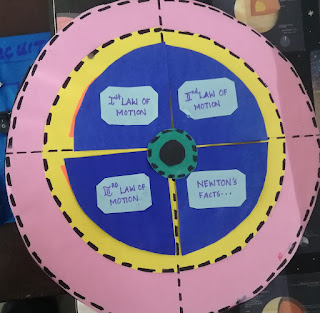Unraveling the Secrets of Newton's Laws of Motion: A Journey Through My Still Model
Becoming a student teacher has been an exhilarating experience for me, especially when I was tasked with the challenge of teaching Newton's Laws of Motion to a class of ninth-graders. While the laws themselves are fascinating, I wanted to find a unique way to engage my students and make the subject matter more accessible. That's when the idea of creating a still model struck me. In this blog, I'll share my journey of constructing a still model of Newton's Laws of Motion using thermocol and how it helped me impart this fundamental concept to my students in an unconventional yet effective manner.
The Concept Behind the Still Model
Newton's Laws of Motion can be quite abstract for students. To bridge this gap, I decided to use a simple wheel made of thermocol as the focal point of my still model. The wheel symbolizes motion, and I divided it into three distinct sections, each representing one of Newton's laws. Here's how I approached each section:
Newton's First Law: The Law of Inertia
For the first section of the wheel, I attached a small car made of cardboard and placed it on a flat thermocol surface. This illustrated the concept of inertia - an object at rest tends to stay at rest unless acted upon by an external force. I encouraged my students to try and move the car without pushing it, highlighting the need for an external force to overcome inertia.
Newton's Second Law: The Law of Acceleration
The second section of the wheel featured a larger car and a smaller one. Both were connected to a string that ran over a pulley. By adding different weights to each car, I demonstrated that the larger car required more force to accelerate than the smaller one. This showcased how force and mass are related, as per Newton's second law (F=ma).
Newton's Third Law: The Law of Action-Reaction
In the final section, I attached two cars facing each other on opposite sides of the wheel. When one car was pushed forward, the other moved backward. This vividly displayed Newton's third law - for every action, there is an equal and opposite reaction. It sparked discussions on action-reaction pairs and the conservation of momentum.
The Interactive Teaching Approach
My approach was not merely about presenting the still model to the students; it was about engaging them actively. Here's how I ensured that:
Hands-On Exploration: I encouraged my students to interact with the model by trying to move the cars, add or remove weights, and observe the reactions. This hands-on experience allowed them to grasp the laws in a practical way.
Questioning and Discussion: I prompted thought-provoking questions such as "What happens if we apply a smaller force to the larger car?" or "Can you identify examples of Newton's third law in everyday life?" This stimulated critical thinking and class discussions.
Real-Life Applications: I related each law to real-life scenarios. For example, we discussed seatbelts (inertia), car accelerations (second law), and even rocket propulsion (third law).
The Impact
As a student teacher, my primary goal was to make learning enjoyable and comprehensible. The still model proved to be a valuable teaching tool. My students not only understood Newton's Laws of Motion better but also became more interested in physics. They appreciated the tangible representation of abstract concepts and actively participated in class discussions.
Conclusion
Creating a still model of Newton's Laws of Motion using thermocol was a rewarding experience as a student teacher. It allowed me to present complex ideas in a simple and engaging way. Teaching is not just about imparting knowledge; it's about inspiring curiosity and a thirst for understanding. My journey with this still model demonstrated how a creative approach can make a lasting impact on students' learning experiences.

.jpeg)


Comments
Post a Comment